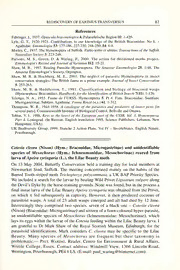
Cotesia cleora (Nixon) (Hym.: Braconidae, Microgastrinae) and unidentifiable species of Mesochorus (Hym.: Ichneumonidae, Mesochorinae) reared from larva of Apeira syringaria (L.), the lilac beauty moth PDF
Preview Cotesia cleora (Nixon) (Hym.: Braconidae, Microgastrinae) and unidentifiable species of Mesochorus (Hym.: Ichneumonidae, Mesochorinae) reared from larva of Apeira syringaria (L.), the lilac beauty moth
. REDISCOVERYOFEARINIUSTRANSVERSUS 87 References Fahringer,J., 1937. Opusculabraconologica4.PalaearktischeRegionIII: 1-420. Lyle, G. T., 1920-1921. Contributions to our knowledge of the British Braconidae. No 6. - Agathidae.Entomologist53: 177-186,227-230,248-250;54: 6-8. Morley,C, 1937.The HymenopteraofSuffolk. Partiotertioetultimo. TransactionsoftheSuffolk NaturalistsSociety3: 223-248. Parsons, M. S., Green, D. & Waring, P., 2000. The action for threatened moths project. Entomologist'sRecordandJournalofVariation 112: 15-21 Shaw, M. R., 1997. Rearing Parasitic Hymenoptera. The Amateur Entomologist 25: 1-46. The AmateurEntomologist'sSociety,Orpington. Shaw, M. R. & Hochberg, M. E., 2001. The neglect of parasitic Hymenoptera in insect conservation strategies: The British fauna as a prime example. Journal ofInsect Conserx'ation 5: 253-263. Shaw, M. R. & Huddleston, T., 1991. Classification and biology of braconid wasps (Hymenoptera: Braconidae).HandbooksfortheIdentificationofBritishInsects7(11): 1-126. Telenga, N. A., 1955. Faune de TURSS. Hymeonptera 5. Pt 4. Fam. Braconidae: Sumfam: Microgasterinae,Subfam.Agathinae.FaunaRossii(n.s.)61: 1-312. Thompson, W. R., 1944-1958. A catalogue ofthe parasites andpredators ofinsectpests [in severalparts].CommonwealthInstituteofBiologicalControl,BellvilleandOttawa. Tobias, V. I., 1986. Keys to the insect ofthe European part ofthe USSR, Vol. 3, Hymenoptera, Part 4. Leningrad. (In Russian. English translation 1995, Science Publishers, Lebanon, New Hampshire,USA). UK Biodiversity Group, 1999. Tranche 2 Action Plans. Vol IV - Invertebrates. English Nature, Peterborough. Cotesia cleora (Nixon) (Hym.: Braconidae, Microgastrinae) and unidentifiable species of Mesochorus (Hym.: Ichneumonidae, Mesocliorinae) reared from larvaofApeirasyringaria (L.),theLilacBeauty moth On 13 May 2004, Butterfly Conservation held a training day for local members at Newmarket Stud, Suffolk. The meeting concentrated mainly on the habits of the Barred Tooth-striped moth Trichopteryxpolycommata, a UK BAP Priority Species. We included a search for the larvae by beating Wild Privet Ligustrum vulgare along theDevil's Dyke by the horse-training grounds. None was found, butintheprocess a final instarlarvaofthe Lilac BeautyApeira syringaria was obtained from the Privet, on which it fed subsequently in captivity. However, it then produced cocoons of parasitoid wasps. A total of 23 adult wasps emerged and all had died by 12 June. Interestingly they comprised two species, seven of a black one - Cotesia cleora (Nixon) (Braconidae: Microgastrinae) and sixteen ofafawn-coloured hyper-parasite, an unidentifiable species of Mesochorus (Ichneumonidae: Mesochorinae), which lays its eggs within the larvae ofthe Cotesia feeding within the Lilac Beauty larva. I am grateful to Dr Mark Shaw of the Royal Scottish Museum, Edinburgh, for the parasitoid identifications. Mark considers C. cleora may be specific to the Lilac Beauty. Man—y species of Mesochorus are frequent but their taxonomy is problematic. Paul Waring, Reader, Centre for Environment & Rural Affairs, Writtle College, Essex. Contact address: Windmill View, 1366 Lincoln Road, Werrington, Peterborough, PE46LS. (E-mail: [email protected]).
